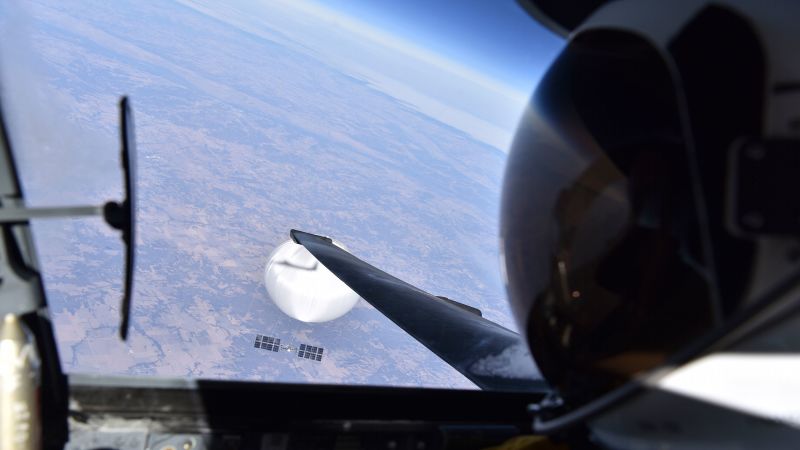China appears to have suspended its surveillance balloon program following a major diplomatic incident earlier this year, when one of the country’s high-altitude spy balloons transited the United States, multiple sources familiar with US intelligence assessments told CNN.
US officials believe that Chinese leaders have made a deliberate decision not to launch additional balloons since the one over the US was shot down by American fighter jets in February, the sources said. The US has not observed any new launches since the episode occurred.
The apparent suspension of the program comes as both the US and China have sought to stabilize an increasingly tense relationship. Asked for comment on the balloon program, Chinese embassy spokesperson Liu Pengyu told CNN that the February episode was “unexpected” and “isolated.”
“Since the incident happened, China has stated repeatedly that the balloon is found to be an unmanned civilian airship used for meteorological and other research purposes, and that its accidental entry into US airspace is entirely an unexpected, isolated incident caused by force majeure,” Liu said. “The facts are clear and shall not be distorted or misrepresented. We hope relevant parties can stop hyping up on this.”
The US intelligence community believes that Chinese Communist Party leaders did not intend for the balloon to cross over the United States, and even reprimanded the operators of the surveillance program over the incident, one of the sources said.
President Joe Biden indicated in June that Chinese leader Xi Jinping was caught off guard by the balloon’s whereabouts, telling guests at a political fundraiser that Xi “got very upset” after the US shot down the balloon because “he didn’t know it was there.” He then compared Xi to “dictators” who become embarrassed when they don’t know what’s going on.
Still, the episode was also embarrassing for the Biden administration, which at the time of the incident was preparing to dispatch Secretary of State Antony Blinken to Beijing in an effort to reopen lines of communication with Chinese leaders. US-Chinese relations had reached a new low months earlier, when House Speaker Nancy Pelosi visited the self-governing island of Taiwan, enraging Xi.
The US ultimately postponed Blinken’s trip as a direct result of the spy balloon, which was first spotted by US officials in January as it lifted off from the small Chinese province of Hainan. The balloon then crossed into Alaska, Canada, and then downward, reentering the US through northern Idaho and moving towards Montana, where it hovered over sensitive sites.
The US assessed at the time that the spy balloon was part of an extensive surveillance program run by the Chinese military, CNN has previously reported. The balloon fleet had conducted at least two dozen missions over at least five continents in recent years, according to US officials.
The suspension of the program is likely China’s way of trying to stabilize its relations with the United States in the run-up to a potential meeting between President Biden and Xi in November at the Asia-Pacific Economic Cooperation summit in San Francisco, said Christopher Johnson, a former senior China analyst at the CIA and now a senior fellow at the Center for Strategic and International Studies.
Although China is unlikely to publicly acknowledge that the balloon was part of an espionage program or announce it will no longer conduct such surveillance on the United States, Johnson said, quietly suspending the program is “a positive step” and likely Beijing’s way of showing the US it is trying to address some of the friction points in the relationship.
“This would be the first signal we’ve seen from the Chinese saying, ‘we know your concerns on this,’” Johnson said.
But how long the suspension might last, Johnson said, is likely an open question and may depend on how – and if – the November meeting goes.
China has repeatedly claimed the device was a civilian research airship that was blown off course by accident and after its detection issued a rare statement of “regret” over the incident.
“It is a civilian airship used for research, mainly meteorological, purposes. Affected by the Westerlies and with limited self-steering capability, the airship deviated far from its planned course,” the Chinese Foreign Ministry said at the time.
The FBI concluded its analysis of the balloon’s remnants earlier this year, and the Pentagon announced in June that the US government assessed that the balloon did not collect intelligence while flying over the country.
“We believe that (the balloon) did not collect while it was transiting the United States or flying over the United States, and certainly the efforts that we made contributed,” Pentagon Press Secretary Brig. Gen. Pat Ryder Ryder told reporters at a briefing, referring to counterintelligence measures the US took to conceal sensitive sites as the balloon crossed over them.
In the wake of the incident, the US widened the aperture of its radar systems so that they could better detect objects traveling above a certain altitude and at certain speeds. The aim was to fix a “domain awareness gap” that had allowed three other suspected Chinese spy balloons to transit the continental United States undetected under the Trump administration, Gen. Glen VanHerck, commander of US Northern Command and North American Aerospace Defense Command, said at the time.
The more sensitive radar systems led the US military to spot more unidentified objects in US airspace, however, leading to three additional shootdowns of unidentified high-altitude objects in the weeks following the Chinese balloon incident.
Read the full article here





